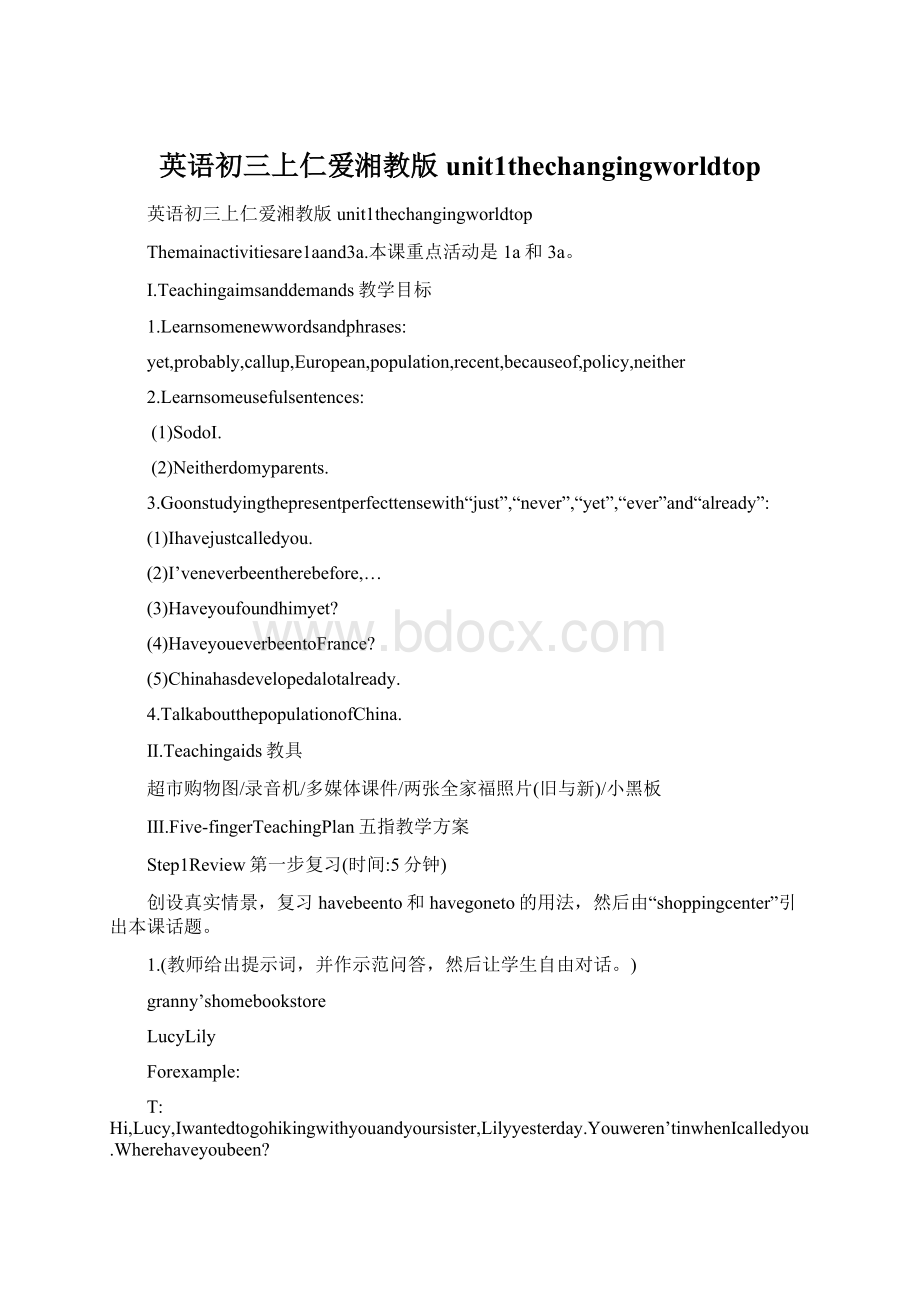英语初三上仁爱湘教版unit1thechangingworldtop.docx
《英语初三上仁爱湘教版unit1thechangingworldtop.docx》由会员分享,可在线阅读,更多相关《英语初三上仁爱湘教版unit1thechangingworldtop.docx(25页珍藏版)》请在冰豆网上搜索。

英语初三上仁爱湘教版unit1thechangingworldtop
英语初三上仁爱湘教版unit1thechangingworldtop
Themainactivitiesare1aand3a.本课重点活动是1a和3a。
Ⅰ.Teachingaimsanddemands教学目标
1.Learnsomenewwordsandphrases:
yet,probably,callup,European,population,recent,becauseof,policy,neither
2.Learnsomeusefulsentences:
(1)SodoI.
(2)Neitherdomyparents.
3.Goonstudyingthepresentperfecttensewith“just”,“never”,“yet”,“ever”and“already”:
(1)Ihavejustcalledyou.
(2)I’veneverbeentherebefore,…
(3)Haveyoufoundhimyet?
(4)HaveyoueverbeentoFrance?
(5)Chinahasdevelopedalotalready.
4.TalkaboutthepopulationofChina.
Ⅱ.Teachingaids教具
超市购物图/录音机/多媒体课件/两张全家福照片(旧与新)/小黑板
Ⅲ.Five-fingerTeachingPlan五指教学方案
Step1Review第一步复习(时间:
5分钟)
创设真实情景,复习havebeento和havegoneto的用法,然后由“shoppingcenter”引出本课话题。
1.(教师给出提示词,并作示范问答,然后让学生自由对话。
)
granny’shomebookstore
LucyLily
Forexample:
T:
Hi,Lucy,Iwantedtogohikingwithyouandyoursister,Lilyyesterday.Youweren’tinwhenIcalledyou.Wherehaveyoubeen?
Lucy:
Ihavebeentoanoldgranny’shometocleanroomsforher.
T:
You’resokind,thenwhereisLily?
Lucy:
Shehasgonetothebookstore.
(教师给出更多的提示词,其中必须有“shoppingcenter”)
S1:
…
S2:
…
…
2.(然后教师问学生Haveyoueverbeentoashoppingcenter?
过渡到1a话题。
)
Step2Presentation第二步呈现(时间:
12分钟)
通过师生问答,引出含有just,ever,never,already,yet等词的现在完成时,让学生学习并掌握。
1.(教师出示一张超市购物图,通过询问学生是否曾去购物,引入本课话题。
)
T:
Lookatthispicture.Whatisit?
Ss:
Itisashoppingcenter/supermarket.
T:
(指向一位学生)Haveyoueverbeentoashoppingcenter/supermarket?
S1:
Yes,Ihave.
T:
Oh,youhaveeverbeenthere.But,haveyoueverbeentoashoppingcenter/supermarketwithyourparents?
S1:
No,Ihaven’t.Ihaveneverbeentherewiththem.(可关心学生回答。
)
(板书并解释ever,never,让学生跟读并掌握。
)
T:
Ithinkmostofyouhaveeverbeentoashoppingcenter.Doyoulikegoingshopping,S2?
S2:
Yes,Ido.
T:
SodoI.ImeanthatIlikegoingshopping,too.Whataboutyou,S3?
(找一名平时不太喜爱购物的同学来问。
)
S3:
Idon’tlikegoingshopping.
T:
Neitherdoesmydaughter.Imeanthatmydaughterdoesn’tlikegoingshopping,either.Lastweek,mydaughterwentshoppingwithme.Thereweresomanypeopleinthestreetthatshegotlost.
Ss:
Didyoufindheratlast?
T:
Yes.MyhusbandcalledmeupwhenIwasworried.Hetoldmeshehadalreadygothome.
(边表达边板书上述画线部分,教师作适当讲解,并要求学生掌握neither。
)
SodoI.
NeitherdoesMydaughter.
have/hasalready+donesth.
callup
T:
Moststudentsprobablylikegoingshopping.WhataboutKangkangandMaria?
Doyouwanttoknow?
OK,let’slearnaboutitfrom1a.
(板书并要求学生掌握。
)
probably
2.(听1a录音,找出康康和迈克尔在购物时发生了什么事。
)
T:
Nowlet’slistentothetape,andfindoutwhathashappenedtoKangkangandMichael.
(核对答案。
)
3.(让学生读1a,回答以下问题。
)
T:
Nowpleasereadthedialogin1abyyourselves.Thenanswermyquestions.
T:
WherehasKangkangjustbeen?
Ss:
HehasjustbeentoashoppingcenterwithMichael.
T:
HasKangkangbeentherebefore?
Ss:
No,hehasneverbeentherebefore.
T:
Doeshewanttogothereagain?
Ss:
No,hedoesn’t.
T:
Now,Iwillaskoneofyoutogiveananswer.Whydoeshehatetogoshopping?
(提问一个学生。
)
S4:
Becausethereweretoomanypeople.Theygotlostandcouldn’tfindeachother.
T:
You’reright.HasKangkangfoundMichaelyet?
(板书并讲解yet在现在完成时的疑问句和否定句中的含义,要求学生掌握。
)
have/hasdonesth.yet
S5:
No,hehasn’t.
T:
WhereisMichael?
S6:
Hehasprobablygonehome.
T:
DoesMarialikegoingshopping,S7?
S7:
No,shedoesn’t.Shehatestogoshopping,too.
Step3Consolidation第三步巩固(时间:
10分钟)
用表演、复述等形式来巩固1a内容,然后通过对话练习巩固含有just,already,yet,ever,never等词的现在完成时,并完成1b和2。
1.(再听1a录音并跟读,然后完成1b,并核对答案。
)
T:
Nowlistento1aagainandthenfollowit.Finish1bandthenchecktheanswers.
2.(两人一组,朗读1a并表演。
)
T:
Workinpairs.Read1aandactitout.
3.(学生依照1a的重点,把对话改写成一篇短文并复述。
)
T:
Accordingtothemainsentences,pleasechangethedialogintoashortpassage.Forexample:
MichaelandKangkanghavejustbeentoashoppingcenter.Kangkanghasneverbeentherebefore.Intheshoppingcenter,thereweretoomanypeople.Theygotlostandcouldn’tfindeachother.AndatlastKangkangthoughtthatMichaelhadprobablygonehome.Kangkangdoesn’twanttogoshoppingagain.
4.
(1)(让学生独立完成2,掌握just,already,yet,ever,never在现在完成时中的用法及含义。
)
T:
I’veneverbeentoanyEuropeancountries.ButMichaelhasbeenthere.Doyouwanttoknowmoreabouthim?
Pleasefinish2.Thenchecktheanswerstogether.
(板书并要求学生掌握。
)
European
(2)(完成2后,练习2并编一个相似对话,巩固练习just,already,yet,ever,never等词的用法。
)
T:
Makeupasimilardialogwithjust,already,yet,ever,andnever.
A:
HaveyoubeentoEgypt?
B:
No,I’vebeentoanyAfricancountries.ButMikehascomebackfromEgypt.Helikesitverymuch.Hesayshehasseensuchabeautifulcountrybefore.
A:
Haveyouseenhim?
B:
Yes,Ihaveseenhim.
Step4Practice第四步练习(时间:
12分钟)
接着谈论Kangkang不情愿去购物中心的缘故,引出并谈论中国的人口变化,呈现3a中的生词、短语和重点语言项目,然后完成3b,巩固3a内容。
T:
WhydoesKangkanghatetogoshopping?
Ss:
Becausetherearetoomanypeople.
T:
Yes.TherearesomanypeopleinChina.Bytheway,S1,howmanypeoplearethereinyourfamily?
S1:
Three,myfather,mymotherandI.
T:
WhenIwasachild,mostfamiliesinourcountryhadatleastthreeorfourchildren.Now,herearetwopicturesofKangkang’sfamily.Lookcarefullyandfindoutthedifferencesbetweenthem.
1.(把事先预备好的两张康康家的照片,用多媒体展示在大屏幕上。
)
(播放3a录音,让学生听一遍课文。
然后与学生一起讨论,引出3a。
)
T:
Nowlet’stalkaboutthetwopictures.
T:
HowmanypeoplearethereinPictureOne?
Ss:
Therearethree.
T:
Yes.It’sanicephoto.Kangkangwassocutethen.Isitabigfamily?
Ss:
No,itisn’t.
T:
Andit’sanuclearfamily.PleaselookatPictureTwo.Isitabigfamily?
Ss:
Yes,itisverybig.Andit’sanextendedfamily.
T:
Itseemsthattheirlivingconditionswerenotverygood.It’saphotoofKangkang’sfather’sfamily.Atthattime,mostfamiliesinourcountryhadatleastthreeorfourchildren.Chinahadthelargestpopulationintheworld.
(教师板书Itseemsthat…,要求学生掌握此句型,并注意和seemto的转换联系。
板书并要求学生掌握population。
)
population
seemto…
Itseemsthat…
T:
Mostfamilieshaveonlyonechildnow.Doyouknowwhy?
Ss:
No,wedon’tknow.
T:
BecauseChinahascarriedoutone-childpolicytocontrolthepopulation.
(板书并要求学生掌握。
)
policy
T:
Becauseofourcountry’sone-childpolicy,greatchangeshavetakenplaceinChinainrecentyears.
(板书并要求学生掌握。
)
becauseof,recent
2.(让学生阅读3a,画出同3b中所给例句意思相似的句子,完成3b。
)
T:
Read3aandunderlinethesentenceswhichhavesimilarmeaningsasthesentencesbelow.
3.(让学生听3a录音并跟读。
)
T:
Listento3aandfollowit.
Step5Project第五步综合探究活动(时间:
6分钟)
给出一些有关人口的话题,让学生分组讨论,然后写出一篇汇报或作文,尽量用上含有just,already,yet,never,ever等词的现在完成时。
让学生尽可能多地了解我国的人口现状,为下一课作预备。
1.(教师用小黑板呈现本课出现的要紧话题。
)
T:
Pleasediscussthesetopics:
〔出示小黑板。
〕
(1)Thepopulationproblem
(2)One-childpolicy
(3)LittleEmperors
(学生自己选一个话题,两人一组进行讨论。
讨论完毕,选几组做汇报。
鼓舞学生发表自己的见解,尊重学生的个性进展,并表达激励机制。
)
Example:
Boysandgirls,
WehavejustlearnedsomethingaboutthepopulationofChina.Haveyoueverthoughtaboutitbefore?
Beforethisclass,Ithinkmostofyouhavealreadyknownsomethingaboutit.…
2.Homework:
(1)Chooseoneofthetopicsabove.Talkaboutitandwriteacomposition.
(2)Makefivesentences.Usethepresentperfecttensewiththewords“just”,“already”,“yet”,“ever”,“never”.
板书设计:
Chinahasthelargestpopulation.
SectionA
callup
ever
+donesth.
have/has
SodoI.never
Neitherdomyparents.already
just
Have/Has…done…yet?
Itseemsthat…
Idon’tthink…
SectionB
Themainactivitiesare1aand2a.本课重点活动是1a和2a。
Ⅰ.Teachingaimsanddemands教学目标
1.Learnanewword:
increase
2.Learnsomeusefulsentences:
(1)Itsaystheworldhasapopulationof6.5billion.
(2)Itisincreasingby80millioneveryyear.
(3)Whichcountryhasthelargestpopulation?
(4)—What’sthepopulationoftheU.S.A.?
—It’s…
(5)Soitis.
(6)Thepopulationproblemismoreseriousindevelopingcountries.
3.Goonlearningthepresentperfecttense.
Chinahasalreadycarriedouttheone-childpolicytocontrolthepopulation.
4.Goonlearningtoexpressthenumberswithmillionandbillion.
5.Makestudentsrealizetheseriouspopulationproblemandhavesocialconscience.
Ⅱ.Teachingaids教具
卡片/多媒体课件/录音机/世界人口示意图/小黑板
Ⅲ.Five-fingerTeachingPlan五指教学方案
Step1Review第一步复习(时间:
8分钟)
复习现在完成时,然后引导学生谈论过去人们生活条件差的缘故,引出人口问题,导入新课。
1.(小竞赛。
教师把学生分为两组。
然后出示写有already,yet,ever,never,just的卡片,要求学生以抢答形式迅速说出含有卡片上词的句子,要求用现在完成时。
迅速且正确者赢一分,评出获胜组。
)
T:
Let’shaveacontesttoreviewthepresentperfecttense,OK?
Ss:
Great.
T:
First,I’lldividethewholeclassintotwogroups.ThenI’llshowthecardswith“already”,“yet”,“ever”,“never”and“just”onebyone.Yourteamwillgetascoreifyougivemeacorrectsentencewiththewordonthecard.Let’sgo!
(教师出示写有already的卡片。
)
T:
“Already”,please!
Group1:
Shehasalreadyfinishedherhomework.
T:
Congratulations.“Yet”,please!
Group1:
Ihaven’twateredtheflowersyet.
T:
Congratulations.Group2.“Ever”,please!
Group2:
HasyoursistereverbeentoTibet?
…
2.(教师让一名学生复述SectionA中3a的内容,引出人口问题。
)
T:
Whocanretell3ainSectionA?
S1:
Ican.
(学生复述课文。
)
T:
Welldone.Canyoutellmewhytheirlivingconditionsdidn’tseemtobeverygoodinthepast,S1?
S1:
Becausethefamilymembersinthepastweremorethanthosenowadays.
S2:
Becauseofthelargepopulation.
S3:
Chinawasnotwelldeveloped.
T:
Right.Butwhat’sthepopulationofChina,doyouknow?
Let’slearnaboutitfrom1ainSectionB.
Step2Presentation第二步呈现(时间:
14分钟)
用多媒体呈现图表,谈论中国及世界人口,呈现1a中重点句型及部分生词。
1.(多媒体展示1b中图表。
)
T:
Hereisachartaboutsomecountries’population.What’sthepopulationofourcountry?
Ss:
It’s1.3billion.(可关心学生回答。
)
(板书句型并要求学生掌握;理解billion。
)
—What’sthepopulationofChina?
—It’s1.3billion.
T:
IsChinaadevelopingcountryoradevelopedcountry?
Ss:
Adevelopingcountry.
(板书并讲解。
)
thedeveloping/developedcountry
T:
Good.Nowpleasetalkaboutothercountries’populationinpairs.
(教师可先做示范,然后让学生进行练习。
)
S1:
What’sthepopulationof…?
S2:
It’s…
S1:
Isitadevelopingcountryoradevelopedcountry?
S2:
It’sa…
T:
Welldone.Wehaveknownsomecountries’population.What’sthepopulationoftheworld?
S3:
6.5billion.
T:
Right.Theworldhasapopulationof6.5billion.Andtheworld’spopulationisincreasingby80millioneveryyear.
(板书单词increase及短语hasapopulationof,并要求学生掌握,延伸讲解increaseby和increaseto的区别。
)
hasapopulationof
increase
increaseby
increaseto
T:
Lookatthechart,whichcountrieshavethelargerpopulation,thedevelopingcountriesorthedevelopedcountries?
Ss:
Thedevelopingcountries.Andthepopulationindevelopingcountriesisgrowingfaster.
T:
Soitis.
(板书Soitis,讲解“so+代词/名词+助动词/be动词/情态动词”结构,并和“so+助动词/be动词/情态动词+代词/名词”的结构进行区分。
)
Soitis.
T:
Inordertosolvethepopulationproblem,whatpolicydoesChinacarryout?
Ss:
One-childpolicy.
T:
Yes.Nowlet’slistento1aandlearnmoreaboutit.
2.(教师放1a录音,让学生听并尽可能地写出对话中的有关数字。
)
T:
Closeyourbooks,listentothetapeandtryyourbesttowritedownthenumbersyouhear.
(教师再放录音,让学生核对写的情况。
)
T:
Openyourbooks.Listenagainandcheckwhatyouhavewritten.
(让学生朗读1a,师生共同解决疑难点。
)
T:
Read1aandpayattentiontothefollo